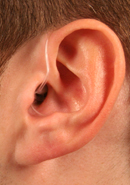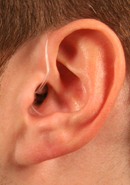A wide range of technology and a host of features are available in each hearing aid style. The cost of hearing aids generally depends on the technology and the number of features the instrument has and not necessarily on the style selected. Today’s digital hearing aids are typically offered in various levels such as basic or entry-level to advanced or premium-level. Within each level, different technology and features are available.
Basic digital hearing aids generally require the wearer to make some manual adjustments in certain listening environments such as turning a volume control up or down, or pushing a button to change listening programs. In contrast, a premium or more advanced hearing aid responds automatically to changes in the listener’s environment, making changes based on the signals being detected by the hearing aid. The hearing aid wearer is not required to make any manual changes. As the level of the technology increases in hearing aids, so do the availability of advanced features.
When selecting Hearing Aids the following is considered:
- Power requirements due to the degree of the hearing loss
- Manual dexterity and visual abilities
- Patient budget
- Cosmetics
- Skin sensitivities
- Anatomical and medical considerations
Styles of Hearing Aids
Hearing aids are available in many different sizes and styles thanks to advancements in digital technology and miniaturization of the internal components. Many of today’s hearing aids are considered sleek, compact, and innovative – offering solutions to a wide range of hearing aid wearers.
In-the-Ear Styles
Hearing aids worn in the ear are usually custom-fit, based on a cast or impression of the ear. They’re available in different skin tones to camouflage with the outer ear. There are several styles – each is listed below, ranging from smallest to largest.

Invisible In The Canal (IIC)
The IIC is the smallest model in hearing aids and it is especially suitable if you have a mild to moderate hearing loss. They are small enough to be placed very deep inside the ear canal allowing users to benefit from the natural shape of the ear for better localisation of sounds. These hearing aids are great as no one will notice you're wearing them.

Completely In The Canal (CIC)
The smallest custom style, CIC instruments fit deeply and entirely within the ear canal. They fit mild to moderate hearing losses and offer high cosmetic appeal as they’re nearly invisible when worn. It is a custom made shell that contains all the electronic components.
For easy everyday removal, the CIC has a small extension cord attached to the outside.

In The Canal
(ITC)
ITC instruments sit in the lower portion of the outer ear bowl, making them comfortable and easy to use. Because they’re slightly larger than CIC models, they have a longer battery life, and can host additional features such as directional microphones for better understanding in noisy environments, and controls such as volume controls. They fit mild and moderate hearing losses.

Full Shell or In The Ear (ITE)
Full shell models sit flush within the outer ear bowl. Their size allows the maximum number of additional controls and features such as directional microphones. They use a larger battery size and can fit a larger receiver with enough power for even some severe hearing losses. They are widely recommended for mild to severe hearing loss.
Behind The Ear Styles
If an in-the-ear hearing device isn’t suitable or desired by a patient, there also are numerous behind-the-ear styles available.
Behind The Ear (BTE) models sit behind or on top of the outer ear, with tubing that routes sounds down into the ear that connects to an ear tip or earmould to secure them in the ear canal. BTEs come in colours to blend with hair or skin tones, and even chrome colors, leopard print and other funky designs to suit personal styles.
Different BTE sizes accommodate different features, controls, battery types and degrees of power (larger instruments generally have more power than smaller ones). While many people choose discreet BTEs that are unnoticeable when worn, others are tempted to show off the cool designs.

Mini BTE with Slim Tube and Tip
Mini BTEs are designed to hide behind the outer ear, and have ultra-thin tubing to discreetly route sound into the ear. The tubing connects to a soft tip that sits in the ear canal but doesn’t occlude it. The result is a natural, open feeling as airflow and sound enter the ear naturally around the tip, while amplified sound enters through the tip. Perfect for mild to moderate high frequency losses

Receiver In The Ear (RITE)
RITE models, also known as RIC (Receiver In Canal) models, are mini BTEs that have the speaker of the instrument incorporated in the ear tip, instead of in the main body of the instrument with the microphone and processor sitting in a tiny case behind the ear. RITE instruments fit mild to severe hearing losses. This hearing aid style looks similar to the Mini BTE when worn on the ear and is a great solution.

BTE With Earmold
BTEs with earmoulds fit mild through profound hearing losses. Their longer shape follows the contour behind the outer ear and can house many features such as a program button and volume control. The earmould colour and style, as well as the wearer’s hairstyle, determine exactly how they’ll look on each person. The tubing that connects the earmold, and the earmold itself, can be cleaned and replaced over time.
